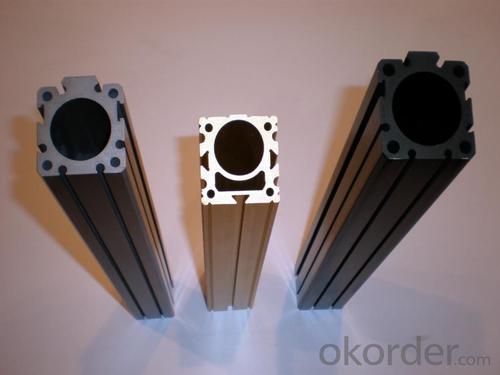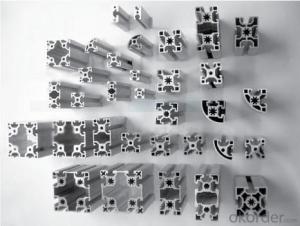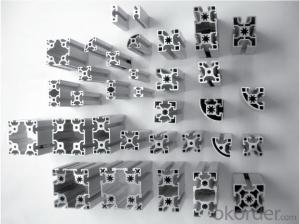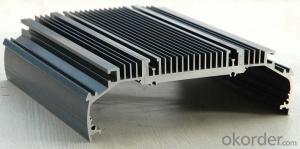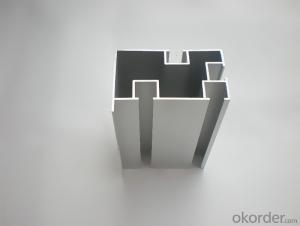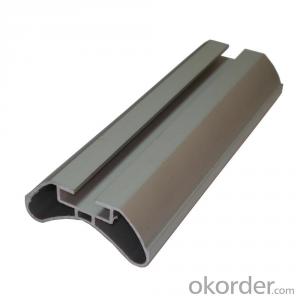Aluminum T-Slot Extrusion Profiles - Aluminium Profile Extrusion
- Loading Port:
- China Main Port
- Payment Terms:
- TT OR LC
- Min Order Qty:
- -
- Supply Capability:
- -
OKorder Service Pledge
Quality Product, Order Online Tracking, Timely Delivery
OKorder Financial Service
Credit Rating, Credit Services, Credit Purchasing
You Might Also Like
Quick Details
| Place of Origin: | Grade: | Temper: | |||
| Application: | Shape: | Alloy Or Not: | |||
| Model Number: | Brand Name: | Certificate:: | |||
| Surface Finish:: | alloy:: | Thickness:: | |||
| Max. Circumcircle:: | 300mm |
Packaging & Delivery
| Packaging Detail: | Aluminium profile pack into brown paper with protective plastic film or as per client's demand |
| Delivery Detail: | 15-30days |
Specifications
Alloy:6063,6061,6005 T5/T6
Finish:mill,anodized,powder coated,wood color;
Cutting,Drill,Punch,Deburr,Bend,Weld;
ISO certified
Aluminium Profile Extrusion
1. What kind of products and service we can provide:
- Aluminum Profile for construction, such as doors, windows, fence, screen, curtain wall, handrail, partition, wardrobe, greenhouse and sunroom, etc.
- Industrial Aluminum Profile for solar energy, LED, machinery, advertisement, transport, auto part, exhibit shelf, telecom. etc.
- Doors and Windows System, include sliding door, side hung window, tilt and turn window, etc.
- Machining for aluminum and S/S products: Cutting, drill holes, punch, milling, de-burr, chamfer, stretch bending, welding and so on;
- Stainless Steel Welded Tubes
- Engineering design and Consult
- Q: Knowledge of aluminum profile warehouse management (detail)
- Warehouse management is the main task required under the factories and production equipment condition of overall planning, rational layout; to strengthen the internal economic responsibility system, scientific division, forming material export management guarantee system; business must implement the work quality standardization, application of modern management technology and the ABC classification method, and constantly improve the level of warehouse management. The main work is material inspection, income, inventory, storage and custody of materials, materials delivery, billing statements, etc.
- Q: What are the regular colors of aluminum profiles?
- White is the normal color! Whether semifinished material or oxidation material! Blank just squeeze out the true color of stone aluminum! Silvery white! Exposure to air for a long time! Occurs naturally oxidizes, can blacken! So we have to do artificial oxidation! The conventional artificial oxidation is white! So there is no special color silver oxide oxidation collectively required! !!!
- Q: This question asks for a comparison of the benefits and drawbacks of utilizing aluminum profiles in the construction of roofs.
- <p>Aluminum profiles in roofing offer several advantages, including their lightweight nature which reduces structural load, high corrosion resistance making them suitable for various climates, and ease of installation which can lower labor costs. They also have a long lifespan and can be recycled, contributing to sustainability. However, there are disadvantages such as higher initial costs compared to traditional materials, potential for dents or damage from impacts, and the need for regular maintenance to preserve their finish and prevent fading. Additionally, aluminum can be noisy during rain or hail, and it may not be as thermally efficient as some other roofing materials, potentially requiring additional insulation.</p>
- Q: This question asks for methods to preserve the look and functionality of aluminum profiles to ensure they last longer and remain in good condition.
- <p>To maintain the appearance and performance of aluminum profiles over time, follow these steps: 1. Regularly clean the profiles with a soft cloth and mild soap to remove dust and dirt. 2. Avoid using harsh chemicals or abrasive materials that can scratch the surface. 3. Apply a protective coating or sealant if the profiles are exposed to harsh weather conditions or chemicals. 4. Inspect the profiles periodically for signs of wear, corrosion, or damage, and repair or replace them as needed. 5. Lubricate moving parts with appropriate oils or grease to ensure smooth operation. 6. Avoid overloading the profiles or using them beyond their specified weight capacity. By following these maintenance practices, you can prolong the life and performance of aluminum profiles.</p>
- Q: This question asks if aluminum profiles can be utilized in the construction of exterior walls and roofs.
- <p>Yes, aluminum profiles are commonly used in exterior walls and roofs due to their durability, corrosion resistance, and low maintenance requirements. They offer a lightweight alternative to traditional materials and can be designed to withstand various weather conditions. Aluminum profiles are also recyclable, contributing to their sustainability. They are often used in modern architecture for both aesthetic and functional purposes, such as in curtain walls, window frames, and roofing systems.</p>
- Q: Can aluminum profiles be used in marine environments?
- Yes, aluminum profiles can be used in marine environments. Aluminum is often chosen for its excellent corrosion resistance and lightweight properties, making it ideal for marine applications. It is commonly used in the construction of boats, shipbuilding, and offshore structures due to its durability and ability to withstand exposure to saltwater and harsh weather conditions.
- Q: Can aluminum profiles be used for stadium seating?
- Yes, aluminum profiles can be used for stadium seating. Aluminum is a lightweight and durable material that is commonly used in various construction applications, including stadium seating. It offers the advantage of being corrosion-resistant, easy to maintain, and can be customized to meet specific design requirements. Additionally, aluminum profiles provide structural stability and can withstand heavy loads, making them suitable for stadium seating systems.
- Q: What are the load-bearing capacities of different aluminum profile shapes?
- The load-bearing capacities of different aluminum profile shapes vary depending on various factors such as the specific alloy of aluminum used, the size and dimensions of the profile, and the specific application or use case. Aluminum profiles, also known as extrusions, come in a wide range of shapes including I-beams, T-beams, square tubes, rectangular tubes, angles, and channels. Each profile shape has its own unique load-bearing capacity due to its structural design and cross-sectional properties. For example, I-beams are known for their high load-bearing capacity due to their shape, which allows for efficient weight distribution along the flanges. They are commonly used in structural applications where heavy loads need to be supported. T-beams, on the other hand, have a load-bearing capacity similar to I-beams but with a different cross-sectional shape. They are often used in applications where a flat surface is required on one side, such as in construction or automotive industries. Square and rectangular tubes are versatile profiles that are often used in building structures, frames, and support systems. Their load-bearing capacity depends on the wall thickness and size of the tube. Angles and channels, which have a L-shaped and U-shaped cross-section respectively, are commonly used in construction and manufacturing industries. Their load-bearing capacity depends on the size and dimensions of the profile. It is important to note that the load-bearing capacities of aluminum profiles are typically provided by the manufacturer and should be consulted for specific applications. Additionally, engineering calculations and considerations such as deflection, bending moments, and safety factors should be taken into account when determining the appropriate aluminum profile shape and size for a given load-bearing requirement.
- Q: Can aluminum profiles be used for curtain walls?
- Yes, aluminum profiles can be used for curtain walls. Aluminum is a popular material choice for curtain wall systems due to its lightweight, durability, and corrosion resistance. It offers flexibility in design, ease of installation, and can accommodate large glass panels, making it an ideal choice for modern architectural designs.
- Q: This question asks for an overview of the various types of aluminum profiles that are frequently utilized in the construction of commercial buildings.
- <p>Commonly used aluminum profiles in commercial buildings include: 1. Extruded aluminum profiles, which are versatile and used for window frames, door frames, and curtain walls. 2. Structural aluminum profiles, used for load-bearing structures and support systems. 3. Architectural aluminum profiles, designed for aesthetic and functional purposes like facades and decorative elements. 4. Industrial aluminum profiles, used in manufacturing and assembly lines. 5. Thermal break aluminum profiles, which reduce heat transfer and are used in energy-efficient buildings. 6. Anodized aluminum profiles, offering enhanced durability and corrosion resistance. These profiles are chosen based on specific project requirements, such as structural needs, design aesthetics, and environmental considerations.</p>
Send your message to us
Aluminum T-Slot Extrusion Profiles - Aluminium Profile Extrusion
- Loading Port:
- China Main Port
- Payment Terms:
- TT OR LC
- Min Order Qty:
- -
- Supply Capability:
- -
OKorder Service Pledge
Quality Product, Order Online Tracking, Timely Delivery
OKorder Financial Service
Credit Rating, Credit Services, Credit Purchasing
Similar products
Hot products
Hot Searches
Related keywords

